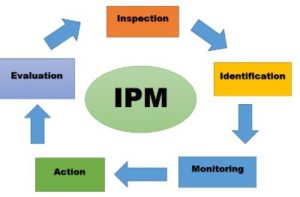20 Aug 2017 New CA Pest Control Laws
By Wolf Baschung, CCIM, CPM /
First Published February 2017 following attendance of LA law firm presentation with no proprietary or original content presented – Updated August 2017. All of the information in this article was publicly available prior to February 2017. None of this infringes anybody’s copyright. Links to article sources below the article.
2017 New CA Pest Control Laws. Integrated Pest Management Is No Longer Optional
In 2017 the California legislature passed new CA pest control laws that will dramatically affect the way bed bug pest control issues are to be handled.
Here are the new and/or amended civil codes pertaining to these new laws:
Civil Code §1942.5 was amended in AB 2281 to prohibit a landlord from retaliating against a tenant who gives notice of a suspected bed bug infestation. In practice, this means that if a tenant as much as complains, even of suspected infestation, a landlord may not file for eviction for any reason (including non-payment of rent), until the matter is fully cleared up.
Civil Code §1954.602 prohibits a landlord from showing, renting or leasing a unit that the landlord knows has bed bugs. It does not require a landlord to inspect for bed bugs, but if a bed bug infestation is apparent, the landlord is considered to have knowledge of bed bugs in the unit. To protect themselves from future lawsuits emanating from such units landlords should have infested vacant units treated and have an approved pest control company issued bed bug clearance on file for all such units.
Civil Code §1954.603 requires that a specific bed bug notice (with specific language and in at least 10 point font) be given to new tenants on and after July 1, 2017, and to existing tenants by January 1, 2018. The following is what the legislature requires and landlords are advised to notify tenants of the entire passage, and can (and should) copy the entire passage verbatim from the civil code section. (Note, the California Apartment Association puts out an excellent form that can be found on Google. Do not overpay an attorney to draft the same).
Information about Bed Bugs
Bed bug Appearance: Bed bugs have six legs. Adult bed bugs have flat bodies about 1/4 of an inch in length. Their color can vary from red and brown to copper colored. Young bed bugs are very small. Their bodies are about 1/16 of an inch in length. They have almost no color. When a bed bug feeds, its body swells, may lengthen, and becomes bright red, sometimes making it appear to be a different insect. Bed bugs do not fly. They can either crawl or be carried from place to place on objects, people, or animals. Bed bugs can be hard to find and identify because they are tiny and try to stay hidden.
Life Cycle and Reproduction: An average bed bug lives for about 10 months. Female bed bugs lay one to five eggs per day. Bed bugs grow to full adulthood in about 21 days.
Bed bugs can survive for months without feeding.
Bed bug Bites: Because bed bugs usually feed at night, most people are bitten in their sleep and do not realize they were bitten. A person’s reaction to insect bites is an immune response and so varies from person to person. Sometimes the red welts caused by the bites will not be noticed until many days after a person was bitten, if at all.
Common signs and symptoms of a possible bed bug infestation:
-
- Small red to reddish brown fecal spots on mattresses, box springs, bed frames, mattresses, linens, upholstery, or walls.
- Molted bed bug skins, white, sticky eggs, or empty eggshells.
- Very heavily infested areas may have a characteristically sweet odor.
- Red, itchy bite marks, especially on the legs, arms, and other body parts exposed while sleeping. However, some people do not show bed bug lesions on their bodies even though bed bugs may have fed on them.
For more information, see the Internet Web sites of the United States Environmental Protection Agency and the National Pest Management Association.
The key here are the two websites the passage indicates should be referred to in the last sentence of the passage. The websites should be included in landlord notices (as per above referenced California Apartment Association notice), and landlords should also be aware that the dense amount of information about bedbugs in these websites are now assumed to be familiar to the landlord under the best practices approach to pest control treatment, and landlords are expected to handle all bed bug pest control matters with full knowledge of all aspects of information entailed in these websites. The websites are:
Landlords should be aware that within the National Pest Management Association website there is a best practices approach to bed bug treatment which outlines everything a landlord must do in order to undertake an Integrated Pest Management approach. This effectively puts landlords on notice and instructs tenants on exactly what landlords should be doing to fully comply with the law (and what landlords are liable for if they do not do so): https://www.bedbugbmps.org/
The second part of Civil Code §1954.603 stipulates that in the tenant notification due by July 1, 2017 (new tenants) / January 1, 2018 (for existing tenants) at the latest, landlords must notify tenants about the procedure for reporting suspected infestations to the landlord. This part contains no suggested language in the bill. In practice it should be crafted carefully so as not only to spell out the landlord obligations for reporting, but also the tenant obligations for reporting. So, for example, such a notice should state that all occupants of a unit, whether or not identified on the lease, are obligated to report suspected infestation. It should further instruct that seeing one or more bedbugs is an infestation. Seeing one or more blood spots on bedding is potential infestation, tenants please report it. Further, the person on management side responsible for receiving, documenting, and taking action on notices should be stipulated in the notice.
Civil Code §1954.604 requires landlords to conduct follow up treatment not only of infected units, but all surrounding until bed bugs are eliminated. This underscores the new standard of care, away from complaint based to comprehensive in nature. addresses entry into a unit to inspect for and treat bed bugs. This section also states that landlords are required to give notice of intent to enter, and very importantly, that tenants are required to cooperate with inspections and requests for information to facilitate bed bug detection and treatment. This is the only part of the law which has changed somewhat in landlords’ favor, insofar as tenants are statutorily obligated to cooperate with landlords and provide landlords access for treatment. Landlords therefore now have legal recourse to fight against tenants who refuse entry for pest control treatment (uncooperative tenants being the ones who most often turn around and sue landlords, as experience shows).
Civil Code §1954.605 requires landlords to notify tenants within two business days of receiving the pest control operator’s findings after an inspection. When infestations are found in common areas, the landlord must provide the notice to all tenants. This means that if a landlord finds bedbugs in a common area, then all residents in the building must be notified of such a finding. In practice it is suggested that actual reports provided by pest control operators be provided to residents rather than putting the management company in the position of interpreting such reports. If reports covering more than one unit have to be redacted to show information only about units being reported on to specific residents, this is would be the preferred way of handling such notifications. Also, any proposed pest control treatment must identify details about chemicals to be used for treatment. Managers will have to coordinate with pest control operators to handle tenant allergies to certain chemicals.
The full text for these new laws as published by the California legislature can be read here: https://leginfo.legislature.ca.gov/faces/billTextClient.xhtml?bill_id=201520160AB551
2016 California Rental Housing Association article on new bed bug legislation.
See also: American Apartment Owners Association article on new bed bug laws.
May 2015 CAA article anticipating new California bed bug legislation and landlord new responsibilities.



